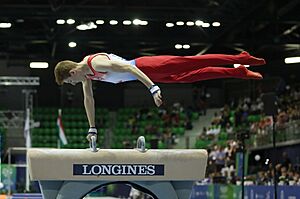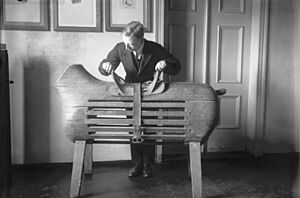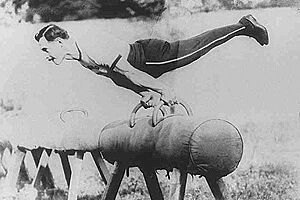Pommel horse facts for kids
The pommel horse is a special piece of equipment used in artistic gymnastics. It is also sometimes called a vaulting horse. Traditionally, only male gymnasts use this apparatus.
Originally, pommel horses were made with a metal frame, a wooden body, and a leather cover. Today, they have a metal body covered with soft foam rubber and leather. They also have plastic handles called pommels. These handles help gymnasts perform amazing moves. There's a similar, simpler piece of equipment called a vaulting buck that is used in physical education classes.
Contents
Discovering the Pommel Horse
The History of this Gymnastics Equipment
The idea for the pommel horse comes from the ancient Romans! They used wooden horses to teach soldiers how to get on and off real horses. Later, this equipment was even part of the ancient Olympic Games.
The basic exercises we see today were developed in the early 1800s. A German teacher named Friedrich Ludwig Jahn, who started the German Turnverein (gymnastics clubs), helped create many of these moves.
How Big is the Pommel Horse?
The exact size of the pommel horse is very important for competitions. The Fédération Internationale de Gymnastique (FIG), which is the international gymnastics federation, publishes these measurements.
Here are the standard sizes:
- Height from the top to the floor: 115 centimetres (3.77 ft) (about 3 feet 9 inches) ± 1 centimetre (0.39 in)
- Length of the top surface: 160 centimetres (5.2 ft) (about 5 feet 3 inches) ± 1 centimetre (0.39 in)
- Length at the bottom: 155 centimetres (5.09 ft) (about 5 feet 1 inch) ± 1 centimetre (0.39 in)
- Width of the top surface: 35 centimetres (14 in) (about 1 foot 2 inches) ± 1 centimetre (0.39 in)
- Width at the bottom: 30 centimetres (12 in) (about 1 foot) ± 1 centimetre (0.39 in)
- Height of the pommels (handles): 12 centimetres (4.7 in) (about 4.7 inches) ± 0.5 centimetres (0.20 in)
- Distance between the pommels: 40 centimetres (16 in) – 45 centimetres (18 in) (about 1 foot 4 inches to 1 foot 6 inches). This distance can be adjusted.
Performing Amazing Routines on the Pommel Horse
A pommel horse routine is a mix of moves using one leg and moves using both legs. Single-leg moves often look like "scissors." However, most of the routine involves double-leg work.
Gymnasts swing both legs in a big circular motion. They can go clockwise or counterclockwise. They perform these moves all over the apparatus. To make routines harder, gymnasts add cool variations. They might turn their bodies (called moores and spindles) or spread their legs wide (called Flairs). They also move their hands along the pommels or the leather surface (called traveling). A routine finishes when the gymnast performs a dismount, swinging off the horse to land on a mat. The Code of Points sets all the rules for these gymnastic elements.
The pommel horse is known as one of the most challenging events for men. While all gymnastics events need strong muscles and great technique, the pommel horse especially favors technique. This is because many moves are done from the shoulders in a leaning, flowing motion. Gymnasts don't usually have to hold still for long periods, unlike in events like still rings or parallel bars. This means less extreme muscle strength is needed in the arms for the pommel horse.
What Makes an International Routine?
For top-level competitions, a pommel horse routine must include specific types of moves:
- Single leg swings and scissor movements.
- Circles and flairs, which can include spins (spindles) or handstands.
- Movements across the horse while supported on the side or crosswise.
- A clear dismount at the end of the routine.
How Gymnasts are Scored
Good form is super important in gymnastics, especially on the pommel horse. The Fédération Internationale de Gymnastique has strict guidelines. For the pommel horse, gymnasts must keep their feet pointed and legs straight throughout the entire routine. Their legs should stay together for most moves. However, for scissors, single-leg elements, and flairs, how they separate and control their legs is judged.
Points are taken off if a gymnast doesn't use all parts of the horse. Pausing or stopping on the apparatus also leads to deductions. And, of course, touching or hitting the horse accidentally will also result in a score reduction.
Celebrating Famous Pommel Horse Gymnasts
Olympic Champions
The most successful Olympic pommel horse gymnast in history is Max Whitlock from Great Britain. He has won three Olympic medals, including two gold medals.
Two other gymnasts have also won three Olympic pommel horse medals across three different Olympic Games:
- Marius Urzică from Romania, with one gold and two silver medals.
- Louis Smith, also from Great Britain, with two silver medals and one bronze. In 2012, Smith would have shared the gold medal, but he was awarded silver after a tie-breaking rule based on execution score gave the gold to Kristian Berki.
Three other gymnasts are considered legends of the sport, each with two Olympic gold medals:
- Boris Shakhlin from the Soviet Union.
- Miroslav Cerar from Yugoslavia.
- Zoltán Magyar from Hungary.
World Champions
The pommel horse event has been a part of the World Artistic Gymnastics Championships since they first began. Several gymnasts hold the record for the most world victories, with three titles each.
Three of the double Olympic champions mentioned above—Miroslav Cerar, Zoltán Magyar, and Max Whitlock—have each won the world title three times. This gives them a combined total of five global titles (Olympics + Worlds).
The most decorated gymnasts at the World Championships are Max Whitlock, Xiao Qin of China, and Kristian Berki of Hungary. Each has won three gold and two silver medals. Even though Xiao and Berki each have one Olympic gold, they are considered major figures in the event's history, alongside the double Olympic champions.
Overall, Max Whitlock is the most successful and decorated pommel horse gymnast in history. He has earned five global gold medals, two silvers, and one bronze.




